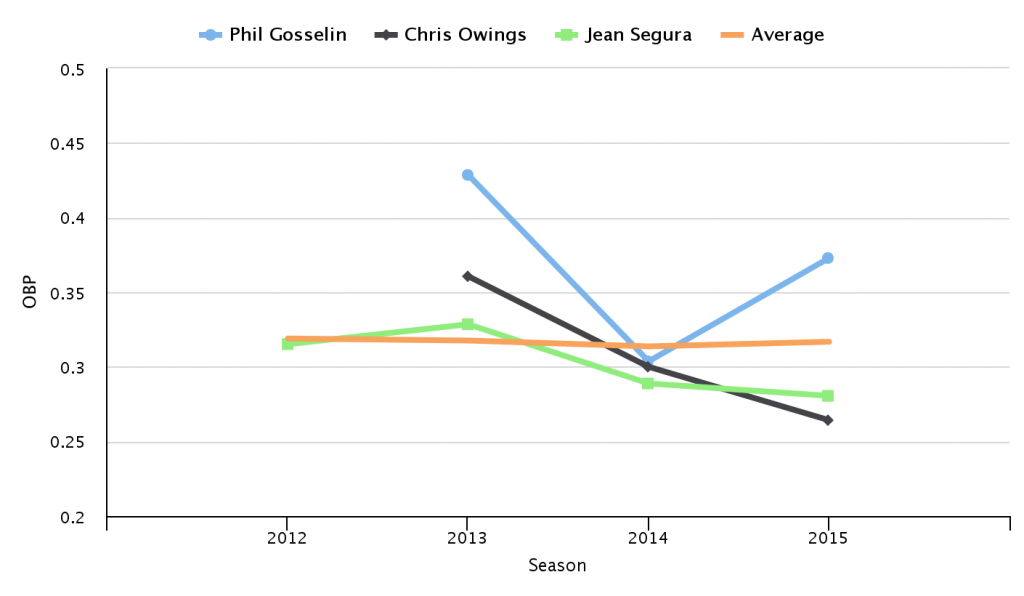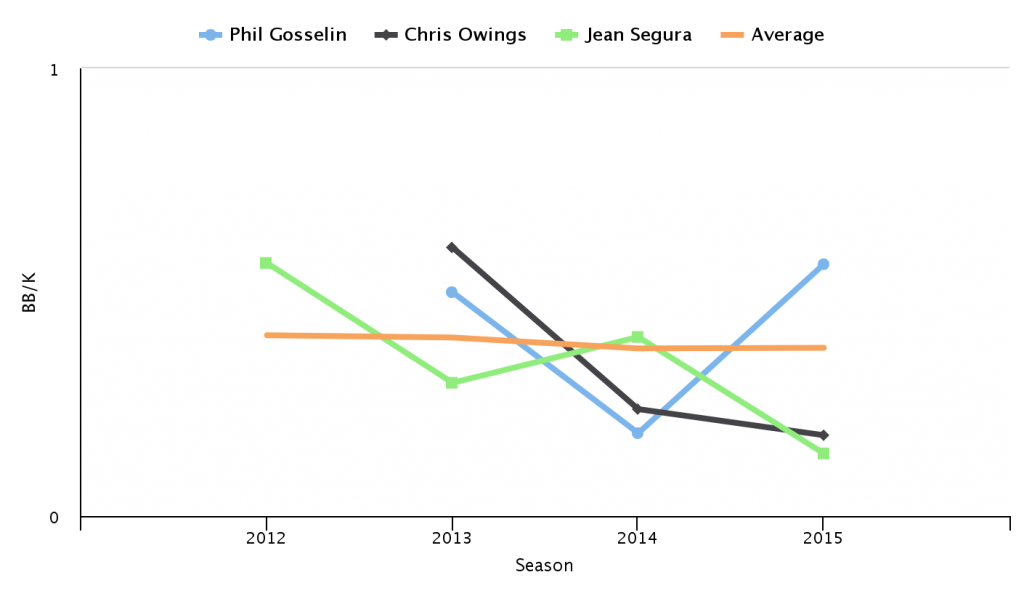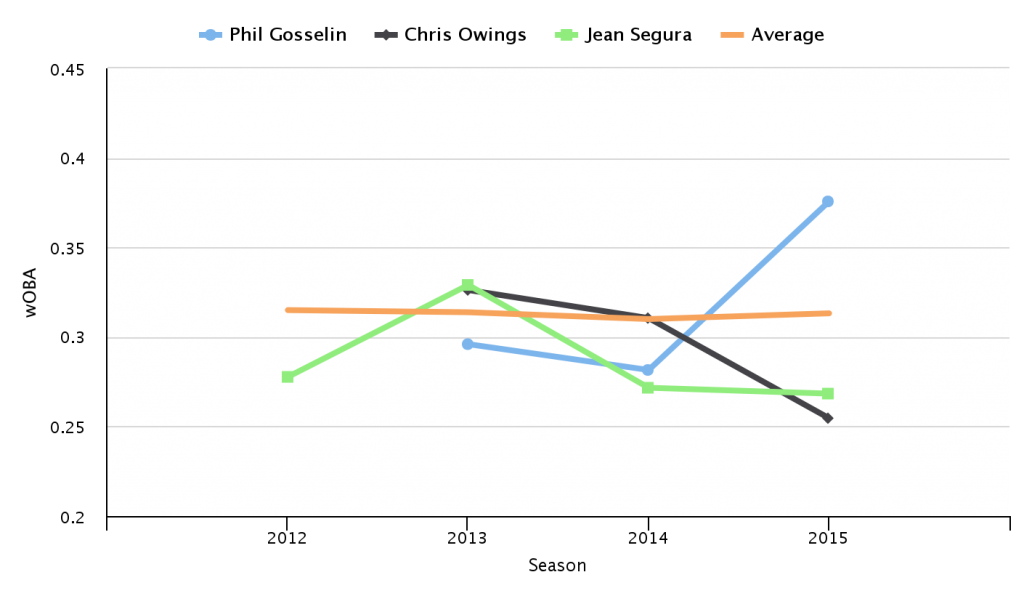Double Plus: Don’t Forget Phil Gosselin
When the Diamondback acquired Jean Segura from the Brewers, I guarantee no one was worried about how adding Segura to the infield mix was going to affect Phil Gosselin‘s playing time. Since coming over from Atlanta in the Touki Toussaint sale, Gosselin has been mostly an afterthought. There’s a reason for this – he’s entering his age-27 season and has just 291 major league plate appearances to his credit. But given just how tremendously paltry the Diamondbacks just might be up the middle this season (at the plate), there’s no real reason not to consider Gosselin.
There is a real duplication of efforts between Segura and Chris Owings since both can play either middle infield position without hitting a ton or getting on base much. Owings might be over his injury and he might not be. He’s still using the two-handed follow-through, so read into that what you will. Nick Ahmed, despite the lack of offense, should be the team’s starting shortstop, so there are really four candidates to get the bulk of the playing time at second: Segura, Owings, Gosselin and Brandon Drury. Yesterday I discussed why I don’t think Drury ultimate breaks camp with the team, leaving it a three-man race in all likelihood.
If that’s the case, it makes some sense to compare the players. Keep in mind the following information, however:
So with a little bit of context laid out, let’s compare some key statistical categories:
On-Base Percentage (OBP)
Walk-to-Strikeout Ratio (BB/K)
Isolated Slugging (ISO)
Weighted On-Base Average (wOBA)
It’s worth noting a few things from the information presented:
- Phil Gosselin holds his own against the competition, or in a couple cases, exceeds it altogether
- Phil Gosselin is a year older than Segura and two and a half years older than Owings
- Phil Gosselin has only 25% as many MLB plate appearances to his name as Owings and only 12% as many as Segura
- Phil Gosselin was worth three times more fWAR than Segura in 2015 (despite only 30% of the playing time) and was worth nearly two and half more fWAR than Owings in 2015 (despite only 28% of the playing time)
You can do what you want with all of the above information. How you want to weight it is up to you. Yeah, he’s older. No, he doesn’t have the pedigree. Yes, he’s been better than the others at times. Yes, those times have been recently. No, there hasn’t been a large sample to study. I really could go on.
Unless Brandon Drury stands head and shoulders above everyone else this spring or there’s a rash of injuries or some guys, not including him, get together and decide it’s a good idea to eat at Chipotle, my bet is that this ends up a three-man race with Drury arriving at a time in the not-so-distant future. Because the other options really aren’t very good and/or Chris Owings may not turn the proverbial corner with his rebuilt swing, Phil Gosselin is in the mix. Considering he’s made big league starts at shortstop, third base and in left field, there’s might just be enough upside to put him on the roster. He hits as well as everyone else at least, and can fill in all over the place. Don’t be shocked if Gosselin takes a bench role for this team, even if it comes at the expense of Drury and Owings.
One Response to Double Plus: Don’t Forget Phil Gosselin
Leave a Reply Cancel reply
Recent Posts
@ryanpmorrison
 Congrats to @OutfieldGrass24 on a beautiful life, wedding and wife. He deserves all of it (they both do). And I cou… https://t.co/JzJtQ7TgdJ, Jul 23
Congrats to @OutfieldGrass24 on a beautiful life, wedding and wife. He deserves all of it (they both do). And I cou… https://t.co/JzJtQ7TgdJ, Jul 23 Best part of Peralta’s 108 mph fliner over the fence, IMHO: that he got that much leverage despite scooping it out… https://t.co/ivBrl76adF, Apr 08
Best part of Peralta’s 108 mph fliner over the fence, IMHO: that he got that much leverage despite scooping it out… https://t.co/ivBrl76adF, Apr 08 RT @OutfieldGrass24: If you're bored of watching Patrick Corbin get dudes out, you can check out my latest for @TheAthleticAZ. https://t.co/k1DymgY7zO, Apr 04
RT @OutfieldGrass24: If you're bored of watching Patrick Corbin get dudes out, you can check out my latest for @TheAthleticAZ. https://t.co/k1DymgY7zO, Apr 04 Of course, they may have overtaken the league lead for outs on the bases just now, also...
But in 2017, Arizona ha… https://t.co/38MBrr2D4b, Apr 04
Of course, they may have overtaken the league lead for outs on the bases just now, also...
But in 2017, Arizona ha… https://t.co/38MBrr2D4b, Apr 04 Prior to the games today, there had only been 5 steals of 3rd this season (and no CS) in the National League. The… https://t.co/gVVL84vPQ5, Apr 04
Prior to the games today, there had only been 5 steals of 3rd this season (and no CS) in the National League. The… https://t.co/gVVL84vPQ5, Apr 04
Powered by: Web Designers@outfieldgrass24
 RT @kileymcd: Source: D'Backs are calling up Daulton Varsho. Son of former MLBer Gary, Top 100 prospect, plus runner with plus co… https://t.co/QHPGqGB7cY, 31 mins ago
RT @kileymcd: Source: D'Backs are calling up Daulton Varsho. Son of former MLBer Gary, Top 100 prospect, plus runner with plus co… https://t.co/QHPGqGB7cY, 31 mins ago RT @Kazuto_Yamazaki: https://t.co/9jtcri4Kp0, 2 hours ago
RT @Kazuto_Yamazaki: https://t.co/9jtcri4Kp0, 2 hours ago Welcome to The VarShow https://t.co/tLlO8AAA7T, 39 mins ago
Welcome to The VarShow https://t.co/tLlO8AAA7T, 39 mins ago Nick Madrigal coming up makes it a great day to be a Beaver #GoBeavs, 3 hours ago
Nick Madrigal coming up makes it a great day to be a Beaver #GoBeavs, 3 hours ago
Powered by: Web Designers










In my opinion this is a great example of when analytics just doesn’t help that much. Call me an old guy who maybe liked Clint Eastwood’s turn in “Trouble with the Curve” more than deserved, but Gosselin gets the highest grade on the eyeball test. I see him as a potential Pollack of the infield kind of guy.